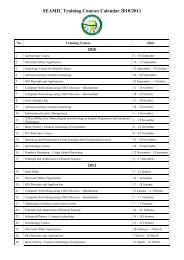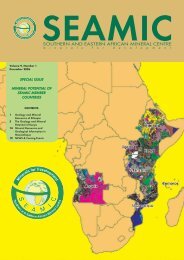SEAMIC Newsletter Vol. 10
SEAMIC Newsletter Vol. 10
SEAMIC Newsletter Vol. 10
Create successful ePaper yourself
Turn your PDF publications into a flip-book with our unique Google optimized e-Paper software.
MINERAL RESOURCES OF TANZANIA<br />
BY GEOLOGICAL SURVEY OF TANZANIA<br />
Tanzania is blessed to have a geological environment conducive for hosting diverse types of<br />
mineral deposits. The country hosts a mining investment area close to one million square<br />
kilometres with litho-types virtually representing all the known chrono-stratigraphical units of<br />
the world ranging from Archean, Proterozoic, Phanerozoic to Quaternary ages. These<br />
geological formations host a variety of minerals such as gold, basemetals, Platinum Group<br />
Metals (PGM), diverse types of gemstones (including tanzanite, diamond, emerald, sapphire,<br />
coloured quartz, ruby, beryl, tourmaline, garnet, etc.), various industrial minerals (coal, salt,<br />
kaolin, phosphates, mica, corundum), building materials and hydrocarbons (mainly natural<br />
gas).<br />
GEOLOGICAL ENVIRONMENT<br />
Much of the central and northern part of the country is underlain by the Tanzanian Archean<br />
Craton. The central part of the country is composed of the high grade metamorphic terrain<br />
whereas the northern part is covered by the Greenstone Belt. The Tanzania Archean Craton is<br />
well known as a host for world-class gold deposits similar to other Archean Cratons around the<br />
world. The Craton is also intruded by a number of diamondiferous kimberlitic pipes.<br />
The Tanzania Archean Craton is engulfed to the southeast and southwest by Palaeoproterozoic<br />
Usagaran and Ubendian mobile belts respectively, with high grade crystalline metamorphic<br />
rocks with a number of post-orogenic gabbroic and granitic intrusives hosting base metals,<br />
shear zone hosted gold, various types of gemstones and industrial minerals. The eastern part of<br />
the Usagaran Belt is mobilized by the Neoproterozoic Pan African Orogeny forming the<br />
Mozambique Belt with lithological, structural and metallurgical characteristics similar to that<br />
of the Usagaran - Ubendian Belt.<br />
The Palaeoproterozoic Ubendian mobile belt is bound to the west by the mildly<br />
metamorphosed Mesoproterozoic Fold Belt. The supercrustal rocks of this Belt are intruded by<br />
post orogenic granites which have alteration haloes containing veins with tin and tungsten<br />
mineralization. The Belt is also characterized by post-orogenic basic intrusives hosting PGM.<br />
The Uha-Malagarasi Neoproterozoic to Early Palaeozoic age is an intracratonic formation<br />
consisting of sedimentary-volcanic depositional sequences of sandstones, quartzites, shales, red<br />
beds, dolomitic limestones, cherts and amygdaloidal lavas with indications of strata-bound<br />
copper deposits and various industrial minerals.<br />
The Phanerozoic formations in Tanzania include the following:-<br />
(i) The Karoo Supergroup of late Carboniferous to Jurassic age<br />
(ii) Marine Formations that are dominated by shelf-facies clay bound sands, marls and some<br />
isolated coral reefs<br />
(iii) Neogene to Quaternary continental formations in<br />
a. isolated basins and river channels composed of clays, limestone, evaporates and sands;<br />
b. volcanic rocks ranging in composition from lavas, tuffs, ash and pumice;<br />
c. volcanic fumarolic exhalative deposits.<br />
7




